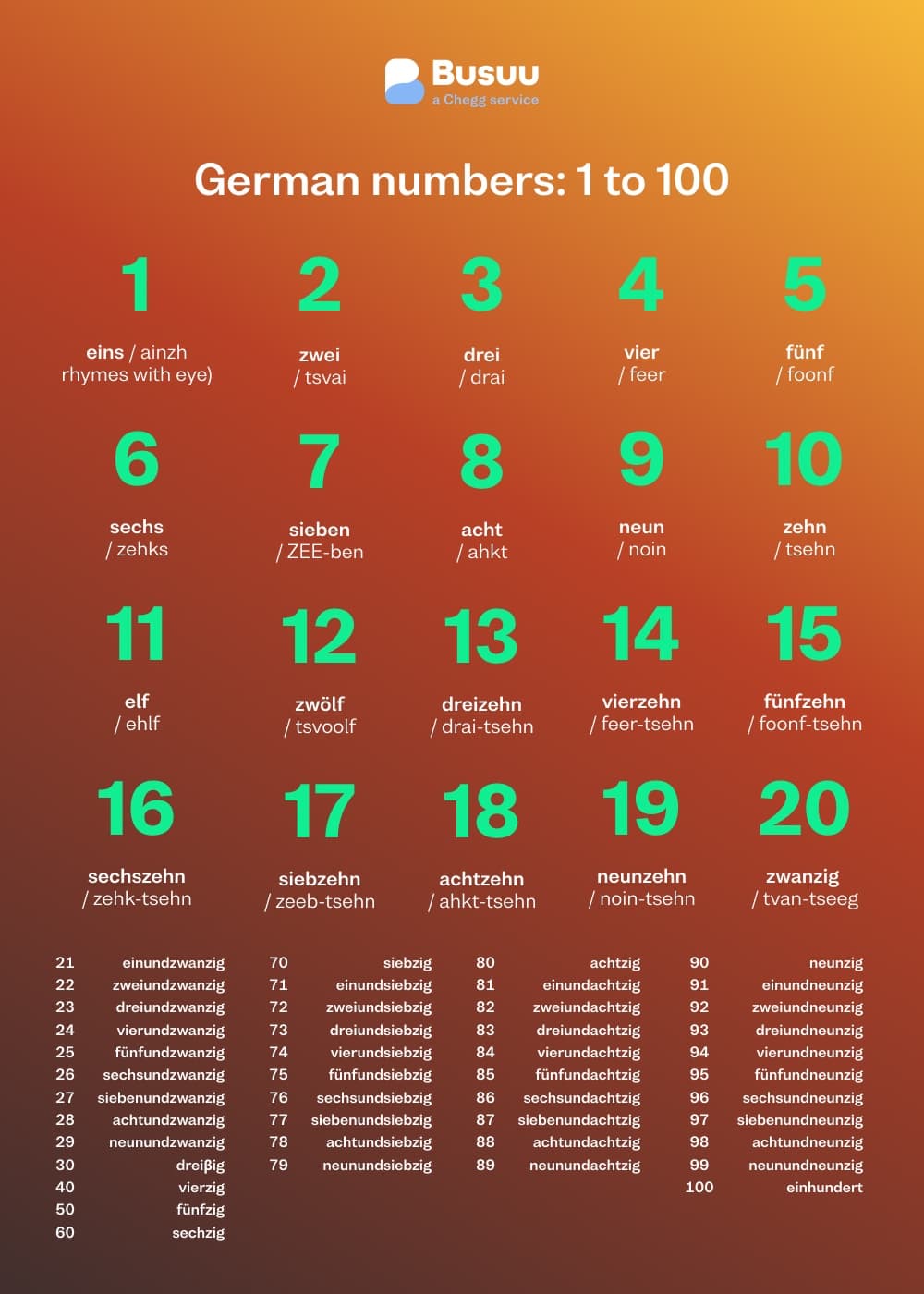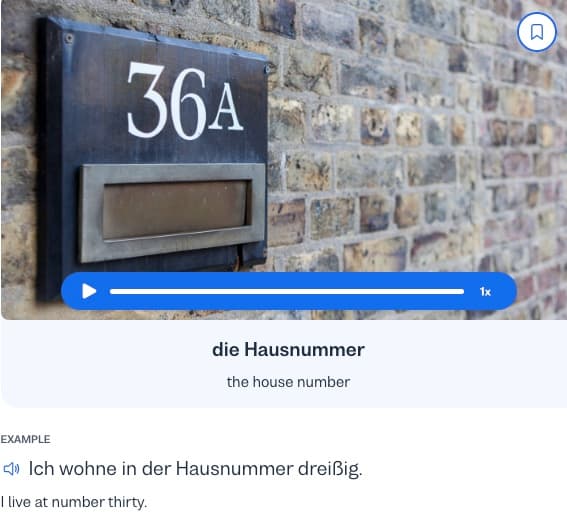I want to learn...
There are about a hundert reasons while you might need to know how to count in German.
From paying at a shop to telling the time to conducting a major business deal, it’s an essential part of learning the language. Fortunately, learning the numbers isn’t too hard with all the hints and cognates from English.
And like everything else with learning German, it follows the rules.
German numbers 1 to 10
| Numeral | German number | Pronunciation |
|---|---|---|
| 1 | eins | ainzh (rhymes with eye) |
| 2 | zwei | tsvai |
| 3 | drei | drai |
| 4 | vier | feer |
| 5 | fünf | foonf |
| 6 | sechs | zehks |
| 7 | sieben | ZEE-ben |
| 8 | acht | ahkt |
| 9 | neun | noin |
| 10 | zehn | tsehn |
The German numbers from 1 to 10 become the building blocks for all larger numbers, so let’s take a moment to make sure we’re pronouncing them right. Since English is a Germanic language, there are lots of cognates and memory tricks you can lean on to help you remember the number names.
0 –Null
First, here’s a bonus number. Null means zero in German, which is very easy to remember from the English words ‘null’ and ‘nil’.
1 –Eins
Eins is not too different from its English equivalent, ‘one’ and rhymes with the English word ‘eye’. Since the German sound ei is used in the German numbers 1, 2, and 3, it makes a nice rhyme: Eins, zwei, drei.
Ein is also the only number in German that needs to be conjugated. Just like we use ‘one’ in English to mean ‘a’ or ‘an’, ein in German functions more as an adjective and changes based on the word it’s modifying. Depending on the gender and case, eins can take the variations ein, eine, einen, eines, einer, or einem.
2 –Zwei
‘Z’ in German makes a ‘ts’ sound, so you can remember that ‘two’ in German also starts with a ‘t’ sound.
3 –Drei
Drei in German sounds a lot like the English ‘dry’, except that it uses a softer, rolled ‘r’ sound.
4 –Vier
Since ‘v’ makes an ‘f’ sound in German, you can remember that this starts with the same sound as four in English. It’s also very close to the English word ‘fear’, with more breath when you pronounce the consonants.
5 –Fünf
Fünf starts with an ‘f’ sound just like the English ‘five’. Remember, the ü sound is pronounced like you’re saying ‘eww’ except with your mouth wider open.
6 –Sechs
Yes, this word sounds very close to a certain word in English — no further memory aid needed. The only difference is that the starting sound is more of a ‘z’ and you should roll the ‘ch’ in the back of your throat.
7 –Sieben
Sieben is close to the English ‘seven’, with a nice long vowel at the start: ZEE-ben.
8 –Acht
The easiest way to remember this number is that is sounds like the prefix oct- as in ‘octopus’ and ‘octogon’, meaning eight. The ‘ch’ sound is hard to master here, similar to a Scottish loch. Roll the sound in the back of your throat like you’re trying to clear something out of there—that’s it!
9 –Neun
While this looks and sounds a lot like the number nine, the middle vowels take a bit of practice. Pronounce neun just like the second syllable of the word ‘annoy’, capped off with another ‘n’ sound.
10 –Zehn
Zehn is pronounced ‘tsehn’ with a starting ‘t’ sound like the English ‘ten’. Make sure to stretch your vowel sound out, similar to the vowel sound in ‘gain’.
German numbers 11 to 20
| Numeral | German number | Pronunciation |
|---|---|---|
| 11 | elf | ehlf |
| 12 | zwölf | tsvoolf |
| 13 | dreizehn | DRAI-tsehn |
| 14 | vierzehn | FEER-tsehn |
| 15 | fünfzehn | FOONF-tsehn |
| 16 | sechzehn | ZEHK-tsehn |
| 17 | siebzehn | ZEEB-tsehn |
| 18 | achtzehn | AHKT-tsehn |
| 19 | neunzehn | NOIN-tsehn |
| 20 | zwanzig | TVAN-tseeg |
Let’s meet arguably the best two German numbers: elf and zwölf. These numbers remind most people of Lord of the Rings or other fantasy lore, with elves and wolves. Zwölf is fun to say once you get the hang of it: practice stringing all the sounds together slowly: ts-voo-lf.
Since you just learned zehn, prepare to use it a lot. Just like the -teen ending in English, German uses -zehn to cap off all numbers 13 through 19. Dreizehn, vierzehn, fünfzehn, you’ll soon get the pattern.
German numbers 21 to 29
| Numeral | German number | Pronunciation |
|---|---|---|
| 21 | einundzwanzig | AIN-und-SVAHN-tseeg |
| 22 | zweiundzwanzig | TSVAI-und-SVAHN-tseeg |
| 23 | dreiundzwanzig | DRAI-und-SVAHN-tseeg |
| 24 | vierundzwanzig | FEER-und-SVAHN-tseeg |
| 25 | fünfundzwanzig | FOONF-und-SVAHN-tseeg |
| 26 | sechsundzwanzig | ZEHKS-und-SVAHN-tseeg |
| 27 | siebenundzwanzig | ZEE-ben-und-SVAHN-tseeg |
| 28 | achtundzwanzig | AHKT-und-SVAHN-tseeg |
| 29 | neunundzwanzig | NOIN-und-SVAHN-tseeg |
| 30 | dreißig | DRAI-seeg |
In English, we use the formula of tens + ones to make larger numbers, such as twenty-five. You might have heard older English phrases using an inverted formula for this, such as ‘four and twenty blackbirds baked in a pie’.
This older way of saying numbers gives a nod to English’s German roots. German builds its compound numbers with this formula: ones + und (and) + tens. Let’s look at an example:
25 =fünf und zwanzig = fünf (5) +und (and) +zwanzig (20)
See how it works? The formula continues on and on the higher up you go.
German numbers 31 to 99
| Numeral | German number |
|---|---|
| 30 | dreißig |
| 40 | vierzig |
| 50 | fünfzig |
| 60 | sechzig |
| 70 | siebzig |
| 80 | achtzig |
| 90 | neunzig |
| 100 | einhundert |
To create any number between 21 and 99, follow the formula of ones +und+ tens. Here are several examples:
31 =einunddreißig=ein (1) +und (and) +dreißig (30)
42 =zweiundvierzig=zwei (2) +und ( and) +vierzig (40)
76 =sechsundsiebzig=sechs+und (and) +siebzig (70)
89 =neunundachtzig=neun+und (and) +achtzig (80)

How to make German numbers 100 and larger
| Numeral | German number | Pronunciation |
|---|---|---|
| 100 | einhundert | ain-HOON-dehrt |
| 1,000 | eintausend | ain-TAU-zehnd |
| 1,000,000 (million) | eine Million | AIN-eh MEE-lee-OHN |
| 1,000,000,000 (billion) | eine Milliarde | AIN-eh MEE-lee-AR-deh |
| 1,000,000,000,000 (trillion) | eine Billion | AIN-eh BEE-lee-OHN |
As you build larger German numbers, there are a few important things to remember:
Large German numbers can be said with or without the article at the start, so you could also simply say hundert.
Numbers in the hundreds and thousands in German are joined together without spaces or hyphens. Only once you reach the millions do you start breaking the numbers up with spaces. This can result in some very, very long words, like dreihundertfünfunddreißigtausendsiebenhunderteinundzwanzig (335,721).
These large numbers start with the biggest units and work your way to the smallest numbers, except for the numbers 21 to 99, which continue to follow their ones + tens formula.
Note that eine Milliarde means one billion in English while eine Billion means one trillion
Examples of German numbers in context
Need a little practice? Here are common ways you may use German numbers in everyday life.
How to say the time in German
Es ist fünf Uhr (It’s five o’clock).
When writing the time, you can also write this Es ist 05.00 Uhr or 5:00 Uhr. Be careful, though. Since Germany uses 24-hour time, this would only mean five in the morning. If you want to say five o’clock in the evening, you would need to say Es ist siebzehn Uhr or 17.00 Uhr.
How to say the year in German
Ich bin neunzehnhundert fünfundachtzig geboren (I was born in 1985).
Das Jahr ist zweitausendzweizwanzig (The year is 2022).
There are two ways to say the full name of a year in German. For years before 2000, you break the number up into two parts, like ‘19’ and ‘85’ for 1985—that’s neunzehnhundert fünfundachtzig in German. Years from 2000 on are made exactly like you would make the number, except that you drop any und in the word. For example, the year 2022 would be said zweitausendzweizwanzig.
Money, Decimal Points, and Commas in German
Would you know what to make of a number like 1.435.646,99?
A large part of the world, including Germany, uses commas in place of a decimal point and decimal points in place of commas in numbers. Confused? Let’s look at a simple example first:
Dieses Hemt kostet 29,50€ (This shirt costs €29.50)
This isn’t a typo for 29,500 euros—that would be a very expensive shirt. This number means twenty-nine euros and fifty cents. Note the comma separator dividing the whole units (euros) from the fractional ones (cents). Larger numbers use a decimal point to separate thousands and larger numbers where English would use a comma.
Also note that prices place the currency symbol at the end of the number, not the start, just like how we speak. You would use € for euros or CHF in Switzerland or Liechtenstein for Swiss Francs.
Ordinal number: How to say first, second, third in German
| Root Numeral | English ordinal | German ordinal | Abbreviation |
|---|---|---|---|
| 1 | first | erst | 1. |
| 2 | second | zweite | 2. |
| 3 | third | dritte | 3. |
| 4 | fourth | vierte | 4. |
| 5 | fifth | fünfte | 5. |
| 6 | sixth | sechste | 6. |
| 7 | seventh | siebte | 7. |
| 8 | eighth | achte | 8. |
| 9 | ninth | neunte | 9. |
| 10 | tenth | zehnte | 10. |
To say first, second, third, and so on in German, follow the pattern above. While erst means first, all the other ordinal numbers end in -te following a form of the number. Just keep in mind that since these are all adjectives, they must be conjugated based on the word they modify.
Instead of 1st, 2nd, 3rd, you can simply abbreviate the ordinal numbers with a full stop. For example, Nehmen Sie die 3. Ausfahrt (Take the third exit) or 1. Februar (the first of February).
Wrapping up
You’ve done it—you’ve counted from eins, zwei, drei to einhundert (with a few bonus numbers!).
Put your energy into memorising the smaller numbers, and the larger ones will follow. Just remember, everything follows a pattern: -zehn for teens, -ig for tens, and -te for ordinal. While it might still take some mental gymnastics to put together a large number in German, you now have all the building blocks you need to make any number.
Viel Glück und viel Spaß (Good luck and have fun!).
Newlanguages


